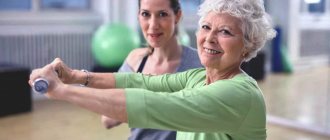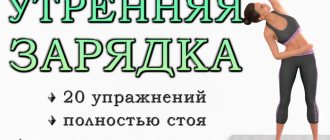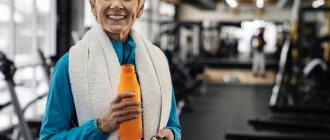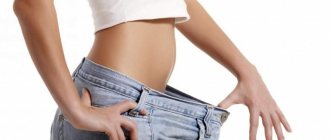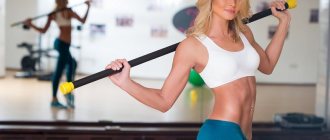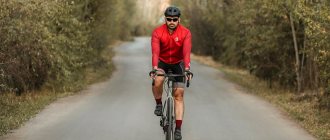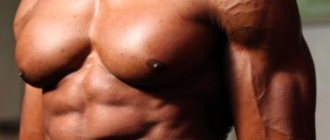From this article you will learn:
- How is exercise beneficial for older people?
- What are the contraindications for exercise for older people?
- How to do exercises for older people?
- Does exercise for older people help with constipation?
- What exercises are included in the complex of exercises for older people for joints?
Today, many older people include outdoor walks, Nordic walking and even running in their daily schedule. Everyone can occupy themselves as they see fit. Some spend time on benches talking about illnesses, others prefer an active lifestyle. Of course, no one wants to spend their last years in infirmity, so exercise for older people is of particular interest. Let's talk about the basic exercises.
Why morning exercises are so beneficial for older people
Physical exercise has accompanied humans for thousands of years. It is impossible to imagine primitive people who did not know how to deftly throw stones, run nimbly, and quickly climb trees. Otherwise, they would not have been able to get food, escape from predatory animals, protect themselves and their fellow tribesmen, and in the end they would simply die out.
On ancient Egyptian frescoes you can see many images of gymnastic exercises. Such activities are still in demand today, and therefore Mikhail Lomonosov’s statement that one must “try in every possible way to be in the movement of the body” does not lose its relevance. Many people, including the elderly, have turned with pleasure to industrial gymnastics of the 60s of the last century.
For a person at a young age, physical exercise is a natural part of life, but by the age of 40–50 it practically disappears. Older people lose their vitality, become weaker, and their movements become slower. And old age is not always to blame for this. Joints, muscles, and ligaments weaken when a person stops moving. The nervous system needs charging, otherwise it loses the ability to control our motor system. Older people begin to stoop and develop a shuffling gait.
For the human body, even regular exercise in the morning is of no small importance; its benefits cannot be compared with any pills. You should not ignore gymnastics, citing your advanced age - constant movement and improved health will help you live an active and rich life for a long time.
Daily exercise for older people, carried out according to the rules, helps strengthen the nervous system and blood vessels, and trains the functioning of the heart. Gymnastics will help an elderly person maintain their posture, gait, improve metabolism, lose weight, and, of course, make them feel cheerful and full of energy.
For older people, morning exercises are important because they can significantly improve their health, despite various ailments: improve the functioning of the respiratory organs, the movement of lymph and blood flow, strengthen the immune system (the latter is especially important for a person of advanced age). Daily exercise prevents the weakening of inactive muscles and helps prevent their atrophy. It has long been known that a sedentary lifestyle directly leads to disease. Elderly people, who by their age have already accumulated a fair amount of ailments, are often doomed to inaction. What kind of exercise can we talk about when a person, due to life circumstances or health problems, has been confined to his home or hospital for years?
In such conditions, for elderly people who are forced to bed, the lack of active physical activity causes great suffering. The saddest thing is that you cannot break out of this circle: a stationary position leads to a deterioration in well-being, and illness does not allow you to move. But even a bedridden patient is prescribed exercises, which, of course, are carried out under the supervision of the attending physician and relatives. Prolonged immobile lying position is fraught with the development of thrombosis and sepsis. Often, exercise is simply a salvation for elderly patients in a similar condition.
Recommended articles on this topic:
- Chinese gymnastics for the elderly: 8 exercises for health and longevity
- Yoga for older people: a set of exercises, recommendations, video
- Exercise machines for the elderly at home: types, advantages, main characteristics
It is quite natural for a person to move a lot every day - sit down, go up and down the stairs, bend over, walk, etc., we don’t even attach much importance to such actions. Many people, when they mention exercise, imagine extremely active dance movements with cheerful musical accompaniment. Classes can be held this way if the body requires such physical activity. But we are talking about exercises for older people who are over 50 years old; it is carried out at a calm pace, with feasible physical activity, and thoroughly works out the joints and muscles. But the main thing is that it brings undeniable benefits.
If older people are still wondering whether or not it is worth doing morning exercises every day, they can be reminded of its undoubted advantages:
- has a tonic effect on the nervous system;
- strengthens the heart, blood vessels and respiratory system;
- prevents the formation of constipation and vein thrombosis;
- improves motor skills, prevents the development of osteoporosis;
- activates metabolism, especially in older people over 60 years of age;
- helps improve immunity.
By doing feasible exercises, older people fill their bodies with energy, and the positive impressions of exercise relieve them of depression, anxious mood, and help them maintain a clear mind.
Proper nutrition for women after 50
General recommendations for nutrition at 50+ are as follows:
- Eat more fruits, vegetables, whole grains and legumes. This will give you plenty of disease-fighting antioxidants.
- Eat more fish. As we get older, we become more susceptible to chronic diseases such as heart disease, stroke, diabetes, Alzheimer's disease, dementia and others. By consuming Omega-3 fatty acids, the healthy fats found in fish, you can reduce inflammation in the body.
- Pay attention to foods containing high amounts of protein. It is necessary for muscle growth and recovery, as well as suppressing hunger.
- Choose foods high in calcium. After age 50, bone density declines, so you need calcium-rich foods to reduce the risk of osteoporosis, prevent fractures, prevent injuries, and keep your bones strong. Women 50 and older need 1,200 milligrams of calcium per day.
- Consume less salt. It retains fluid in the body and thereby increases blood pressure. Avoiding table salt is an important step towards a healthy diet.
- Add foods rich in vitamin D to your diet. Women over 50 years old should take 600 milligrams of vitamin D per day (this is an average value; a doctor should give more precise recommendations). It promotes the absorption of calcium, ensures normal functioning of the thyroid gland and blood clotting. Good sources of vitamin D: fatty fish (salmon, tuna, mackerel), cow's milk, egg yolks, cod liver, etc.
Physical exercises for older people and its principles
For older people, exercise will always be enjoyable if you follow two simple rules. First: exercises that actually bring benefits and are approved by the attending physician are selected for classes. Second: a person must want to do gymnastics; one cannot force him to do this. Movement should bring joy, and the desire to exercise should be voluntary.
So, at the beginning of classes, it is necessary to give older people the opportunity to watch the exercises, which they will do themselves in the future. At the same time as demonstrating the movements, it is necessary to explain in an accessible form what benefits they bring. Charging exercises should be repeated evenly, the load should be distributed approximately equally. It is necessary to take into account the capabilities of an elderly patient when deciding to increase the intensity of exercise.
We recommend
“Gymnastics for older people: the best exercises for various diseases” More details
If possible, all relatively healthy parts of the body should be involved during exercise. If performing an exercise causes pain or discomfort to a person, it should be replaced with another, more gentle one. During exercise, for older people over 60 years of age, it is advisable to ensure that an instructor or relative is present at the lesson. It is important to constantly monitor the condition of older amateur athletes and ensure that their reaction is positive.
The following must be remembered:
- If it is discovered that the elderly person is tired, performs the exercises reluctantly or with visible effort, the exercise should be stopped.
- When the patient performs the exercises on his own, this is active exercise; if the exercises are not carried out without assistance (he is helped to raise his arms, roll over, shake, rub) this is passive exercise.
- 10–20 minutes are enough to do the exercises!
- During exercise, it is necessary to monitor the breathing of older people: inhalation should be calm, voluntary, exhalation should be deep, and the person should not strain. The movements are smooth, calm, at a measured pace. If the exercise is carried out with a bedridden patient, a pillow should be placed under his head to prevent a rush of blood.
- If morning exercises are a joy for older people, it is allowed to increase light exercises, while it is recommended to reduce difficult ones. You should approach repetitions wisely: starting with two times, gradually increase their number to eight. The left-right exercises should be the same.
- It is no coincidence that exercise is called morning exercise - it is most effective to do it in the morning, before eating, in a cool room. It is better to start with a calm walk or a light step in place if there is not enough space in the room. During a break, you can walk around the rooms.
Features of the female body after 50 years
The capabilities of the body and organism inevitably change over the years and irreversible aging processes begin. How is it shown?
- Decreased muscle mass
. In 2011, the German journal Dtsch Arztebl Int published a study in which scientists found that starting at the age of 30, men and women lose an average of 10% of their muscle mass until the age of 40. However, starting from the age of 50, this figure increases to 15% per decade. This is why physical activity, and especially strength training, is so important to keep the body in good shape and prevent atrophy. - Decreased aerobic capacity. Starting at age 30, aerobic capacity decreases by 3-6% every 10 years. Moreover, after 70 years this figure increases to 20%.
- Decrease in anabolic hormones that promote the formation of testosterone, growth hormone, insulin-like growth factor, etc. This slows down injury healing and the recovery process, and also increases the likelihood of developing fatty deposits.
- Decreasing the volume of blood
pumped with each heartbeat. - Decreased bone density.
Scientists have determined that women are more prone to osteoporosis, which is why they are more likely to be injured and receive fractures.
Where to start with a set of morning exercises for older people
When exercising, it is important for older people to adhere to the principle of “do no harm” and monitor the functioning of the cardiovascular system. To do this, you need to be able to determine the reserve of the heart.
This concept refers to the maximum heart rate (HR) minus the resting heart rate. It is not difficult to calculate your resting heart rate; the main thing is not to forget: a person must first rest for at least 15 minutes. For example, 55 beats per minute came out. You need to write down: resting heart rate – 55.
Next, the maximum heart rate (HR max.) is calculated. For this purpose, age is subtracted from 180. For example, if a person is 65 years old, then the calculation will be as follows: 180 - 65 = 115. The resulting value is written down again: maximum heart rate - 115 beats per minute. Therefore, the pulse of an elderly person when charging should not be more than 115 beats per minute.
Important! If the maximum heart rate is exceeded, you need to reduce the load!
Once the calculations are ready, the cardiac reserve can be calculated. From 115 (maximum heart rate), 55 (resting heart rate) is subtracted, resulting in the number 60. It indicates 100% reserve. What purpose is pursued when this value is calculated? The fact is that until the age of 60, it is allowed to increase the heart rate by 100%, and at the age of 60–70 the value can only be increased by 90%.
It is permissible for 70–80-year-old people to use 50%, and for centenarians who have crossed the 80-year mark, no more than 40% of the cardiac resource.
You cannot sharply increase your heart rate - the load should be a maximum of 20% of the obtained value of the human heart reserve. The procedure can be demonstrated using the previously given example. The difference between maximum heart rate and resting rate for a 65-year-old man was 60 beats per minute (100%). At this age, it is necessary to use only 90%; as a result, the number of pulse beats during exercise in elderly people over 65 years of age is allowed to increase only by 54 per minute. Further calculations are made: 20% of 60 is 12. This means that in the first classes it is allowed to increase the heart rate by only 12 beats per minute.
We recommend
“A set of exercises for the elderly: body and breathing” More details
It is recommended that an elderly person or his assistant make all the necessary calculations in advance and write them down in a notebook to be guided by them during exercise to monitor the condition.
Exercises for older people: the best exercises
In the most prominent place in the house you need to hang a poster with some motivating motto about good spirits and the benefits of physical education. There are many variations of morning exercises for older people, promoting rehabilitation after illnesses, solving problems with joints, and constipation. Many older people like exercise videos, where the trainer comments on them in parallel with the demonstration of the exercises. To begin with, you can try to practice according to the description:
- “Letter T” An elderly person needs to sit on a strong chair, put his hands on his knees, and place his feet comfortably. On the count of “one-two” - the hands are moved to the shoulders and then to the sides, inhale. On the count of “three-four”, the opposite action is done: hands to the shoulders, on the knees. The back is straight. Repeat 4 times.
- “Dancing”
Elderly people doing exercises hold on to the seat of a chair to give stability. One - the right leg straightens, two - it returns to its place, three - the left leg straightens, four - it returns to its place. Repeated four times. - “Shoulder circles”
Stand up and take a stable position. Place your hands on your shoulders. For four counts, a large circle is performed with the elbows. In the same way, on four counts, the movement is made in the reverse order. - “Leg to Leg”
To perform this exercise, older people grab the seat of a chair. On the count of “one”, cross the right leg over the left, muscles tense, inhale. Two - the leg returns to the starting position, the muscles relax, exhale. If it is difficult, the old man may not bend his knees. On the count of “three-four” an identical movement is made, but from the left foot. Repeat 4 times. - “Balloon”
You need to lie on your back, bend your knees, put your hands on your stomach. Start breathing with the diaphragm: once - inhale through the nose, the stomach inflates; two - exhale slowly, the stomach retracts. An older person may experience dizziness, so it is necessary to monitor his well-being. - “Passing the ball”
Arms are spread out to the sides, legs are brought together. In your right hand is a ball or some other object convenient for moving. Inhale: once - under the bent knee, the ball is transferred to the left hand. Exhale: two - return to the starting position. Inhale: three - the ball is transferred from the left hand to the right under the left knee, exhale: four - return to the starting position, inhale. Repeat 3 times. - “Rolls”
Lie on the floor. Arms to the sides, legs together, in the right hand - a ball or other convenient object. Inhale. Once - move your straight right hand to the left, rolling your body, transfer the ball to your left hand, exhale. Two - return to the starting position without the ball, inhale. Three - the body rolls with a straight left arm, the ball is transferred to the right hand, exhale. Four – return to the starting position, inhale. This exercise makes breathing difficult, so older people need to be careful. - “Ball over your head”
The exercise is done in a lying position. The hands are located along the body, in the right there is a ball. Once - with sliding movements along the floor, the hands are raised behind the head, the ball is transferred to the left hand, if possible, the movements are accompanied by a glance, inhale. Two - the hands return to their original position, exhale, the ball is transferred from the left hand to the right. Repeat 6 times. - “Rotation”
They make rotations with their feet and fists - 4 circles inward, four circles back. The arms are bent at the elbows, the legs are placed wide. - “Swimming on your back”
Legs in a straight position, arms calmly located along the body. Once - the right hand rises, it is placed behind the head, the left leg rises at the knee, sliding the foot along the floor, inhale. Two – return to the starting position, exhale. Three – the left arm is raised behind the head, the right leg is bent, inhale. Four – return to the starting position, exhale. - "Stone and cotton wool"
A person lies on the floor, legs together, arms along the body. Once - the body tenses (the hands are clenched into fists, the feet and buttocks are pulled towards themselves), inhale. Two - all the muscles of the body relax, exhale. Repeat six times. This exercise is unique for an elderly person; despite its apparent simplicity, it effectively affects the muscles. - "Star"
In a lying position, place your legs side by side and extend your arms along your body. Once - the left leg and right arm are moved along the floor to the side, inhale. Two – return to the starting position, exhale. Three - the right leg and left arm are moved along the floor to the side, inhale. Four – the starting position is assumed, exhale. It happens that it is difficult for older people to perform the exercise, then you can simplify the movements - abduct your left leg and arm at the same time.The time has come to measure the number of pulse beats per minute. You need to remember what frequency is the maximum and stick to it.
Next, we suggest that you familiarize yourself with exercises for older people, which are done while lying on their stomach.
- “Beach”
Place your hands in a “shelf” position in front of you. Raise your head and look up. Once - the head turns to the right, lowers onto the hands with the left side. Relax, breathe out. Two - return to the starting position, look up, inhale. Three - the head turns to the left, falls on the hands. Relax, exhale. Four – take the starting position, look up, inhale. Repeat 4 times. - "Boat"
Arms extended forward, legs brought together. Once, place your right hand on your buttocks. Two - left. Three - the chest and head are raised as high as possible, the gaze is directed forward. Four - arms return to the starting position, relax. If possible, repeat three times.Attention: this exercise is difficult for older people, as it puts a significant load on the spine!
- “Let’s rest”
Place your head on your hands, brought together in front of you in the proper manner. It is easy and natural to bend and straighten your knees in turn. - “Airplane”
Stand up, leaning on your palms and knees. Once - extend your right arm forward, take your left leg back, inhale. Two - maintaining balance, return to the starting position on all fours, exhale. Three - the left arm is extended forward, the right leg is extended back, inhale. Four – take the original position, exhale. - "Dragonfly"
The exercise is performed in a position on all fours. Once - the right hand is moved to the right, the movement is followed by the gaze (the head turns at the same time). Two - the hand returns to the floor, exhale. Three - the left hand is retracted to the left side, you need to follow the movement with your eyes, turning your head. Four - the body returns to its original position, exhale.Attention: while performing this exercise, it is quite difficult to maintain balance, so older people should be supported!
- "Long Arm"
Lying on your stomach, you need to stretch forward, alternately changing your right and left hand. Once - the right one stretches as far as possible, the body helps, inhale. Two – return to the starting position, the body relaxes, exhale. Three - the left hand reaches forward, inhale. Four - the body returns to its original position. Relax, breathe out. Repeat three times.After this, you need to again check the number of pulse beats in one minute. Remember what frequency is the maximum and make sure that its level is not exceeded. For older people, this part of charging should become mandatory.
- “Cat”
Get on all fours. Rest your knees and palms on the floor, taking a stable position. Once - the back arches upward as much as possible, inhale. Two - bends down, exhale. Repeat four times, avoiding sudden movements. - “Affectionate dog”
Get on all fours again. Place your knees and palms firmly on the floor. Once - move your back to the maximum to the right, inhale. Two - bend the body to the left, exhale. Repeat 4 times, avoiding sudden movements (especially if the elderly person is over 70 years old). - “Rolls”
Sit on a chair, holding the seat with your hands for stability. Bend your knees at a right angle. Roll your feet from heel to toe and back. Repeat six times. - “Wings”
Sit on a chair, place your hands on your knees. Once - arms rise up through the sides, inhale. Two - kneel down, body slightly tilted forward, exhale. Repetition is allowed 5 times.
Exercise for the elderly with a stick
Exercise 1. “Leverage”
The gymnastic stick is placed on the floor, its end is fixed and held by the soles of the feet. Place your hands on top of the stick, spread your knees. Inhale. Slowly straighten your arms while maintaining balance. Leaning on the stick, tilt your body forward so that your head is between your elbows. Then slowly return to the starting position. These movements must be slowly repeated six times. If an elderly person has a good vestibular apparatus, he can supplement the exercise by slowly rotating the upper end of the stick clockwise when bending over and counterclockwise when lifting.
Exercise 2. “Mill”
Sit on a chair. Take the stick, holding it horizontally between your palms. Once - turn the stick vertically, while placing its lower end on the right thigh so that the right hand is at the top. Two - return the stick to its original position, exhale. Three - the left hand goes up, and the lower end of the stick falls on the left thigh, inhale. Four - the stick returns to its original position, exhale. Repeat 4 times.
Exercise 3. “Rolling pin”
Try to press the stick to your back with both elbows, spreading your legs for greater stability. Keeping your back straight, roll the stick over it with your elbows up, inhale, trying not to lean down, then exhale.
Next, measure the number of pulse beats per minute again. Remember the indicators of your maximum frequency, try not to exceed them. This part of the classes is mandatory for every elderly person.
What exercises consist of exercises for joints in older people?
People can experience joint problems both young and old. They are accompanied by pain, limited movement, joint immobility and make life very difficult. We can say that every day a person seems to begin to learn to walk again. First, feeling immobilized, awkwardly getting out of bed, then trying to move on poorly bending legs, you don’t even have to think about bending and squatting. If a person is familiar with such problems and this condition of the joints does not surprise him, he should definitely do the exercises given below. It is especially worth emphasizing that we are talking specifically about morning exercises - the day should begin with these activities.
We recommend
“Joint pain in older people: causes, types, methods of treatment” Read more
After waking up, stretching right in bed (after removing the high pillow), you can start exercising for the joints, starting with the upper body.
Recommended neck exercises:
- tilt your head, bending your neck, back and forth: look at your chest, slowly throw back your head, look at the wall behind the bed;
- remaining in a lying position, turn your head to the right, look at your shoulder, then, turning your head, look at your left shoulder;
- keeping your shoulders motionless, tilt your head to the right side, try to touch your shoulders with your ear, tilt your head to the left, try to touch your left shoulder with your ear.
This exercise should be done very carefully (especially for older people), without making sudden movements, smoothly. Otherwise, charging may lead to dizziness.
Next comes a warm-up for the arms. Exercises are carried out for the joints of the hands and elbows. The following exercises are performed while lying on your back:
- Each joint of the phalanx should be massaged with light movements. Each finger, including the thumb, is extended and bent. You need to work through the exercise in the “fist-palm” mode, straightening your fingers to the maximum. For old people, doing such a task can be quite problematic.
- Move the brushes in a circle in one direction and in the other. Complaints from older people about pain are most often associated with this exercise, so it is better not to rush when performing it, or to reduce the number of rotations.
- To perform the next exercise, you need to sit down with your legs off the bed. Straighten your arms, trying to fully straighten your elbow joint. If you don't succeed the first time, you need to try again.
If you still want to lie in bed, you can do the following exercises. Sit up in bed, helping yourself with your hands. Then lie down again. For older people, it is better to complete this task with someone’s help.
Having assumed a sitting position in bed, there is no need to rush to get up: the joints of the legs are not yet ready for such a change in position, especially if we are talking about older people.
Exercises for the knee joints of the elderly:
- lower your feet to the floor, actively move your toes - clench and unclench them;
- the moment has come when you need to start kneading the capricious ankle joint, to do this you need to carefully describe circles with your foot in the left and right directions;
- the next movement is like in gymnastics: pull your toes;
- We move our feet in the opposite direction - we pull them towards ourselves;
- bend the leg at the knee, slowly straighten it - this is how to warm up and work out the knee joints, which most often ache and hurt in bad weather in older people;
- stand up, move your knees left and right, crouching a little;
- Complete the exercise by walking in place - an exercise for the hip joints.
What it is?
The basis of Kegel exercises
- contraction and relaxation of the pelvic muscles in different positions and tempos.
Special gymnastics for the muscles of the perineum became known in the mid-20th century thanks to the American gynecologist Alfred Kegel
. But can he be considered the first creator of the technique? After all, exercises for intimate muscles are part of Indian and Chinese practices that humanity has known for many millennia.
Kegel began to promote them because of their therapeutic effect. But almost immediately his gymnastics became known as sexual exercise. Yes, working intimate muscles improves sex life
, giving both partners bright emotions. But this does not make the therapeutic effect any less. The useful is combined with the pleasant.
Does exercise help with constipation in older people?
Unfortunately, constipation is a common companion in the lives of older people. That's why it's so important to know how to deal with them. Medicines can have harmful effects on the body. But exercise is exactly the remedy that will help a person quickly eliminate the problem, again feel lightness in the body and encourage the body to work “without downtime.” If you want to get rid of constipation, you should try to do therapeutic exercises with music for older people every day. It will be difficult - you can reduce the time of classes, but just don’t give up on them completely. Over time, everything will return to normal, and a cheerful state can be maintained by exercising once every two days.
Contraindications
But every action has a reaction. Likewise, the medical complex has its own “buts” that prevent its use:
- cervical erosion: muscle contraction leads to even greater disruption of the integrity of the epithelium;
- benign and malignant tumors, cysts;
- inflammation in the female organs: vaginitis, urethritis, cystitis, endometritis and others;
- diseases of the heart and blood vessels: thrombophlebitis, severe form of varicose veins;
- uterine bleeding;
- the period after surgery, and not necessarily the genitals.
To ensure that nothing worries you while doing gymnastics and not to risk your health, consult your doctor first.
